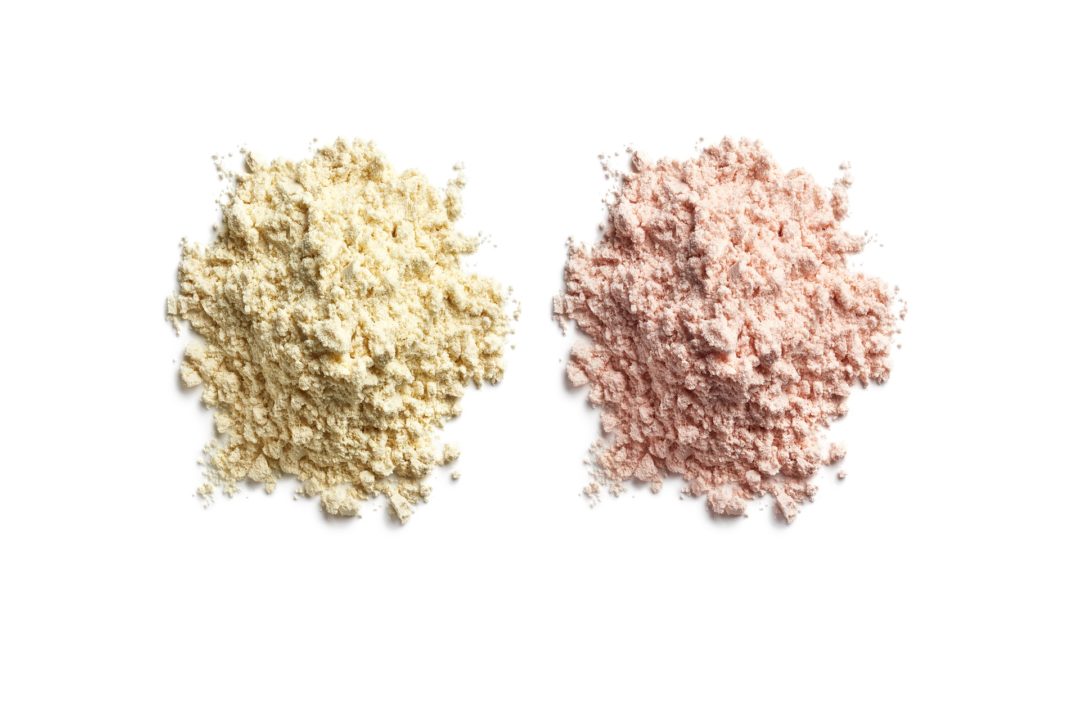What is Protein?From keratin, a major component in hair and nails, to hemoglobin, which gives red blood cells their color, proteins play an important role in developing and repairing muscles, bones and numerous parts of the human body. These “building blocks of life” are actually made up of chains of thousands of smaller units called amino acids, of which there are 20 types that combine to make a protein (1). Eight of the 20 amino acids are considered “essential,” meaning they must be consumed through foods.
Traditionally, people have gotten their share of protein by eating animals or vegetables (2). Animal sources can provide a “complete source” of protein, meaning they contain all essential amino acids, while vegetable sources typically lack one or more (2). While being a complete source, some people are concerned about the health detriments of getting protein solely from animal sources — for instance, the amount of saturated fat found in those foods. Increasingly, dietary supplements are entering the mix.
High protein diets have typically been consumed by athletes, but more recent trends have members of the general population trying an increased-protein diet to help with weight loss (2). While protein supplements can provide a boost and be beneficial to a high-exercise lifestyle, there are questions about what the impact is for the average person, and what intakes are healthiest (2).
Types of SupplementsMany types of protein supplements are on the market today, generated from either animal or plant sources. The two main animal sources are whey and casein.
Whey makes up 20 percent of the protein in bovine milk, while casein makes up the other 80 percent (2). Whey is found through separation from casein in milk or as a by-product of making cheese. Whey contains all nine essential amino acids and is considered a complete source of protein (3). The supplement can also be broken down into different forms. Whey powder, for example, is used as an additive to beef, dairy and snack products throughout the food industry (2).
Casein is similar to whey in many ways. It makes up the rest of the protein in bovine milk, also contains all essential amino acids and can be made as a by-product of cheese production (4). It differentiates in the bioactive compounds it carries. Casein contains bioactive peptides that have been shown to benefit immune and digestive systems, while whey has active proteins called immunoglobulins that boost the immune system (4).
There are many plant-based sources, too. Pea proteins, for example, have been booming recently with the market expected to reach $34.8 million by 2020 at a CAGR of 8.80 % from 2015 to 2020 (5). Pea protein comes from ground yellow split peas, and is not derived from common allergenic foods, which is helpful to those with restricted diets (6). Peas are a good source of nutrients such as fiber, vitamin K and copper, among others, and high in the essential amino acid lysine but low in methionine (7).
Brown rice is commonly used as a source of protein, too. The protein is extracted from rice and used in supplements. It is not a complete protein because it lacks the amino acids lysine and threonine. Rice protein does have more of the amino acid arginine (8).
Protein can be extracted from hemp through the seeds of the plant. Hemp protein is not considered a complete source and, like other plant or seed sources, it is low in the essential amino acid lysine (9). The two main proteins in hemp are edestin and albumin (10). Hemp seed has high levels of the amino acid arginine and is lactose-free and safe for people with allergies such as peanuts or soybeans (9).
Originating from the soybean plant, soy is the most-used plant-based protein supplement. Soy is one of the only non-animal supplements still considered a complete source (2). Due to its qualities, soy is a common source of protein for people who are vegan or lactose intolerant (2). Forms of soy protein include powder, soy milk and soy fiber (11).
Delivery MethodsProtein supplements derived from animal sources can generally be taken as powders, concentrates and isolates. In whey, isolates are the purest form of protein, while concentrates contain more biologically active components (2). Plant proteins like soy can be separated into flours, concentrates and isolates. Soy isolates contain the greatest concentration of protein.
Pea, hemp and brown rice protein supplements can also be found in powder forms (18). Taking different amounts of powder supplements impacts how much protein the body absorbs, and in turn affects weight control and muscle gain.
What Science SaysResearch shows people should be getting 10 to 35 percent of their calories from protein, and most should eat 50 to 60 grams of protein per day (12). More than that could be giving the body more than it can handle and process, which can overwork the kidneys and is a waste (6). While this is not dangerous for most adults, it is recommended that individuals with existing kidney disease limit their protein intake (2). A high-protein diet can cause problems like harmful buildups of urea, phosphorus and acids in people with existing disease. For most people, getting protein through food is enough, but there are some situations where supplements are key (6).
A high-protein diet can help cause reduced feelings of hunger, along with weight loss. (13). It can also help people who are working out and exercising more, and athletes recovering from injuries. People who are vegan or vegetarian can also use protein supplements effectively to help them recover, repair the body and provide themselves with protein in a way that fits their lifestyles (14).
Healthy Habits When SupplementingPeople taking supplements generally consider it part of a healthy lifestyle (15). Overall, diet is still key, and most people can get all the protein they need from eating meals, without supplements. That said, supplements can be helpful for losing weight and supporting more active lifestyles. There are several key things to keep in mind when recommending protein supplements to your customers. Plant-based proteins do not always have all the essential amino acids, so it may be better to suggest a blend (6). Plant-based proteins have been shown to help reduce the risk of obesity, high blood pressure and diabetes, making them appealing to consumers looking for support in those areas (16). Another thing to consider when using supplements for weight management is timing. A 2018 study found that consuming protein supplements with meals, instead of between meals, can more effectively promote weight control and reduce fat mass without impacting other potential benefits (17).
References:(1) https://ghr.nlm.nih.gov/primer/howgeneswork/protein
(2) https://www.ncbi.nlm.nih.gov/pmc/articles/PMC3905294/
(3) https://www.medicalnewstoday.com/articles/263371.php
(4) https://www.healthline.com/nutrition/casein-vs-whey#origin
(5) https://www.marketsandmarkets.com/Market-Reports/pea-protein-market-36916504.html
(6) https://www.jrnjournal.org/article/S1051-2276(17)30151-6/fulltext
(7) https://www.todaysdietitian.com/newarchives/1216p32.shtml
(8) https://www.uofmhealth.org/health-library/hn-10008595#hn-10008595-how-it-works
(9) https://www.uofmhealth.org/health-library/hn-10013908
(10) https://link.springer.com/article/10.1007/s10681-004-4811-6
(11) https://www.webmd.com/vitamins/ai/ingredientmono-975/soy
(12) https://www.webmd.com/diet/news/20170901/protein-powder-can-provide-boost-but-at-what-cost
(13) https://www.sciencedirect.com/science/article/pii/S1550413106002713
(14) https://www.webmd.com/vitamins-and-supplements/features/protein-powder#1
(15) https://www.ncbi.nlm.nih.gov/pmc/articles/PMC3931917/
(16) https://www.jrnjournal.org/article/S1051-2276(17)30151-6/fulltext
(17) https://academic.oup.com/nutritionreviews/article-abstract/76/6/461/4980809?redirectedFrom=fulltext
(18) https://www.healthline.com/nutrition/best-vegan-protein-powder

2025 Natural Choice Awards
March 31, 2025








